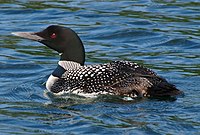
Photo from wikipedia
Background and Aim: Coccidian infection (coccidiosis) is one of the most important causes of illness and death in the fish population, including Asian sea bass. The fingerling developmental stage is… Click to show full abstract
Background and Aim: Coccidian infection (coccidiosis) is one of the most important causes of illness and death in the fish population, including Asian sea bass. The fingerling developmental stage is sensitive to various infectious agents. Economic losses are sustained by the sea bass aquaculture industry due to coccidiosis annually. However, the related pathological changes in the Asian sea bass fingerlings’ three-part intestine remain unknown. This study aimed to investigate the Asian sea bass fingerlings’ infection rate, infection location and site, and specific pathological lesions in the small intestinal tissues in a marine cage farming operation. Materials and Methods: A cross-sectional study was conducted on 44 fingerling fishes. Major coccidia proportions were identified morphologically at both the macroscopic and microscopic levels. The infection number was determined based on coccidia presence at various intestinal locations and sites. All areas were assessed for pathological lesions using semi-quantitative grading. Analysis of variance was used to perform all data analyses using the SPSS software. Data were expressed as means ± standard deviation. p < 0.05 was considered statistically significant. Results: All Asian sea bass fingerlings studied were infected with coccidia. Enteritis and mucosal necrosis were distinct lesions found in the anterior intestine, which had the highest infection rate (49.94%), followed by the mid intestine (35.63%), and the posterior intestine (22.43%). The most common coccidian infection site was extracellular (subepithelial), followed by intracytoplasmic, and epicellular sites. Histopathological lesion determination revealed that intestinal tissue inflammation and epithelial injuries were predominantly seen in the anterior gut (p < 0.05). Conclusion: There was a high coccidian infection rate in Asian sea bass fingerlings from marine cage farming operations. Infection and intestinal damage at the anterior intestine, a major site, led to fingerling death. Disease prevention in the nursery should be intensive from the fingerling period to decrease the fatality rate caused by coccidia.
Journal Title: Veterinary World
Year Published: 2022
Link to full text (if available)
Share on Social Media: Sign Up to like & get
recommendations!